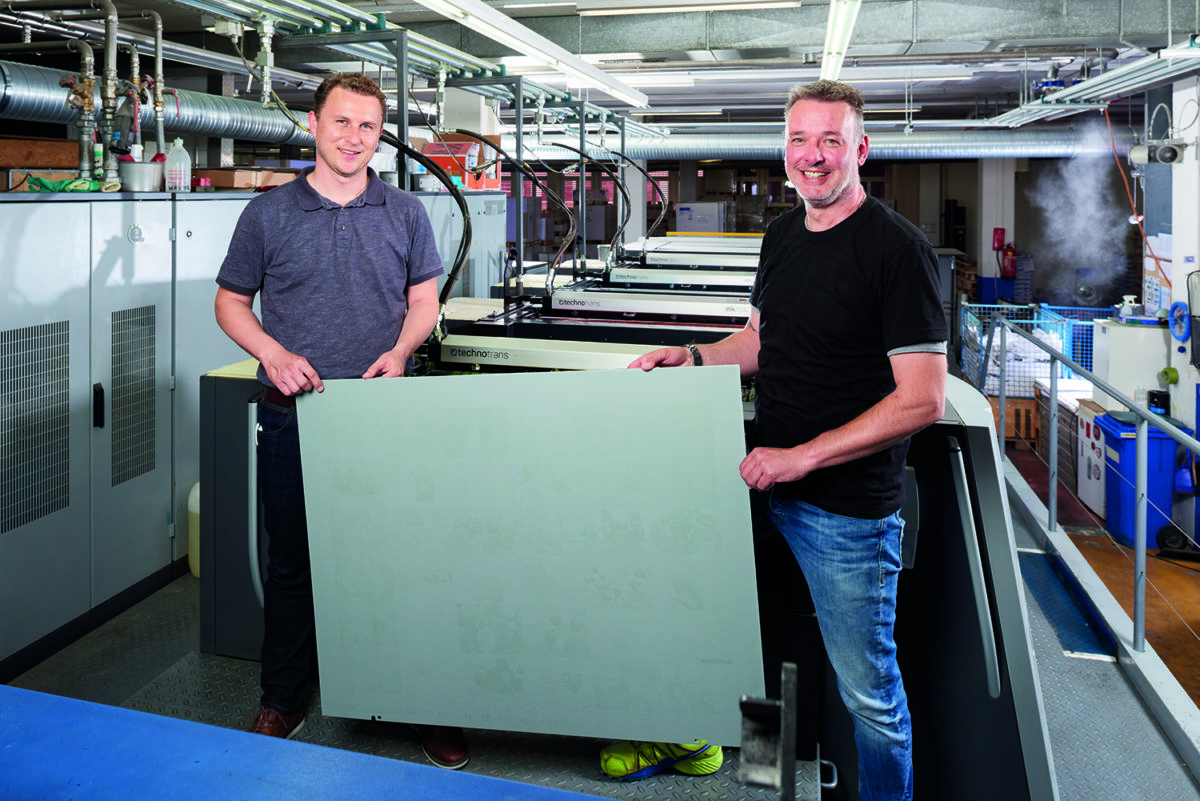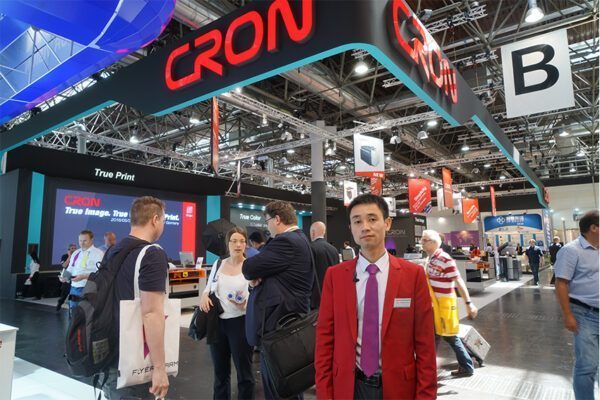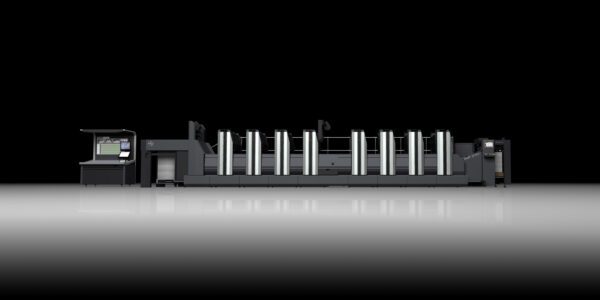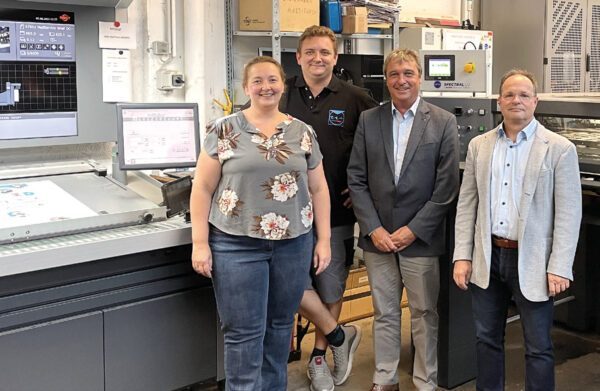Druckzentrum Büelholz belongs to the club of "industrial print shops" in Switzerland: an eight-color and a six-color sheet-fed offset press in 70×100 format, an extremely extensive range of finishing machines, 50,000 m2 of printing plates used per year. Something is going on! Interesting fact: the Büelholz printing center has been using Fujifilm Superia ZE processless printing plates for the past six months.
Text: Paul Fischer / Image: Chromos Group
Processless or chemical-free?
Processless or chemical-free printing plates have been used in Switzerland for over ten years. From an ecological point of view, the use of such technologies is impressive. However, there have always been limitations: chemical-free plates require a wash-out and gumming solution, processless plates are "fully developed" in the printing press and the print image is recognizable before clamping in the press with weaker contrast compared to conventional thermal plates. The maximum run length has always been a sticking point with such plates. With the advent of sheet-fed offset presses configured for the use of highly reactive UV offset inks, print shops had to fall back on "classic" thermal printing plates anyway. This is why large, industrially oriented print shops were always a little reluctant to use these plates. Since March 2020, Druckzentrum Büelholz in Egg, Canton Zurich, has been fully committed to processless plates, a decision that was carefully considered and took time to mature. And the right product at the right time: the Fujifilm Superia ZE.
The background
Three people were involved in the decision to introduce the Superia ZE at the Büelholz printing center: Stefan Balmer, Head of the Work-flow/CtP department, Patrick Senn, Production Manager, and Patrick Martin, Offset Sales Manager at the Chromos Group. The decision did not come out of the blue, of course, as the Chromos Group has been supplying the printing center with printing plates for over fifteen years. Stefan Balmer, who always keeps a close eye on technological developments, had been looking into the development of processless plates for some time. But he didn't want to take any risks: "We work industrially in three shifts, so there's no room for uncertainties and experiments. All our work processes have to be right and we can't afford any downtimes. That's why I followed the developments in processless printing plates very closely, but for a long time there simply wasn't the right product for us." Patrick Martin: "Before the Superia ZE, Fujifilm offered various types of plates in the processless sector. They had their specific strengths, but also weaknesses. The Superia ZE provided a further boost in contrast, as well as a high level of print run resistance of up to 200,000 print runs. This enabled us to offer the Büehlholz printing center exactly what they needed." Stefan Balmer comments: "When Patrick Martin first presented the Superia ZE to us, I knew immediately that this was exactly the kind of processless plate that we could introduce with a clear conscience. We looked at the plate with a user and after an extensive test phase, we made the switch in spring 2020."
Fundamentals
Patrick Senn explains the fundamental advantage of a processless plate very vividly: "As the name suggests, a processless plate does away with an important process, namely the development of the plate using chemicals. This makes the entire manufacturing process of such a plate significantly more stable and safer." Stefan Balmer goes one better: "Where are the biggest potential problem points in printing plate production? In the platesetter? No, the biggest risk factor is the development of the chemistry. What many people don't realize is that the developing machine is the natural weak point in every CtP system. It requires the most maintenance and cleaning and is much more prone to breakdowns than any other unit in a CtP process."
So why are not all print shops using processless plates?
Stefan Balmer: "The process itself is of course simpler, but the technological effort on the plate is all the greater. Fujifilm, for example, took ten years before they were able to offer a product like the Superia ZE. Of course, there are still limitations, such as the less visible print image on the plate as long as it is not in the machine. This leads to different points of view. If you tell a prepress specialist that a printing plate no longer needs a chemical development process, they are immediately on board. The printer, on the other hand, doesn't like it if he only sees what's on the printing plate after inking."
Patrick Senn: "Today, we work with digital data everywhere. All the workflow systems for the printing presses are also based on it. The digital data that I use to expose the printing plate is also the same digital data that I use to control the color values during the printing process. If these processes are set up and the procedures are carried out correctly, the manufacturing processes are one hundred percent reliable. In a situation like this, why should I still rely on plate revision, which made perfect sense in the analogue age but is now unnecessary thanks to digitalization?"
And what about the costs? Processless panels are more expensive than conventional panels.
Stefan Balmer: "Yes, processless plates cost more. But I don't need any more chemicals, I don't need the high-maintenance processor, so if I really do the math, a processless plate is cheaper than a conventional one."
The triumph of processless panels?
For Patrick Senn and Stefan Balmer, the switch to processless plates was a resounding success. Stefan Balmer: "The process is safer, we save 500,000 liters of water and 3,200 liters of development chemicals per year." What remains, however, is the challenge for the printers. In addition to the low contrast and the fact that the plate runs freely in the printing press, a slightly different ink and water flow is required compared to conventional printing plates. This is why the printers were involved in the evaluation of the processless plate right from the start. Patrick Senn: "That was extremely important for the whole thing. You can't just go in and change the printing plate processes from one day to the next without having the printers on board." After more than six months with the Superia ZE, there can only be one way forward for him: "It took a long time to find a product that met our requirements. Of course, you shouldn't generalize, but I believe that the use of processless printing plates will become the standard in graphic arts companies."
Patrick Martin can also confirm that they are on the way there - at least in Switzerland: "60% of the printing plates we sell in Switzerland are already processless. The outstanding properties of the Superia ZE have accelerated this process." The fact that it is not even faster can be attributed to a specific circumstance. Patrick Martin: "As mentioned, the Büelholz printing center saves over half a million liters of water per year. This is an important argument in many countries, where water is an expensive resource. In Switzerland, on the other hand, where water is dirt cheap, awareness does not go that far." However, he assumes that the use of process-free plates will become "mainstream" in the long term. Stefan Balmer: "There is now simply no reason not to work with processless printing plates, and we are a typical example."
Büelholz printing center
Druckzentrum Büelholz emerged from the former Comprinta AG. Due to the continuing decline in print volumes, the idea of independent B2B print shops was, or rather had to be, sharpened once again. Patrick Senn: "We specialize in high-quality offset printing, print finishing and logistics. Our team of employees works in three shifts using state-of-the-art technology. By bundling print jobs in the print center and using lean and highly efficient processes, we offer our customers excellent value for money. This also enables us to produce much more economically than smaller companies can do on their own. Druckzentrum Büelholz never acts as a competitor to print shops, but prints exclusively for these companies. We don't have a sales force on the market, but rather we accept our clients' print jobs and complete them. We are the printer for printers!"
Focus and efficiency
But is it all worth it in times of declining print volumes and shrinking margins? Patrick Senn: "In contrast to other competitors in the 70×100 segment, we focus exclusively on what we are good at: standardized yet diversified print production, as efficient and flexible as possible, also thanks to a 7/24 operation if necessary. We do not have an extensive prepress department; these are available at our partners and we process the supplied, print-ready PDFs. Our office staff is very lean and, as already mentioned, we have no sales representatives. In this form, we are uniquely positioned, at least in German-speaking Switzerland." A look at the company's key figures shows that Patrick Senn's statements are understandable: around 50 employees process 5,000 print jobs and move 4,000 tons of paper every year. Against this background, the successful use of Fujifilm's processless Superia ZE is an important benchmark: what works in a company like Druckzentrum Büelholz, where absolute process reliability and high productivity are the key criteria, will also work for all other possible users in the graphic arts industry. Processless is "mainstream". This statement by Patrick Martin is certainly not presumptuous when looking at Egg.



